This article submitted by contributing author Jennifer Berroth~
“In chorus, it would probably help a lot if teachers talked about the physiology of the voice . . . I think choral teachers underestimate how much students are able to understand.” Student subject quoted in Freer, P. (2009). Boys’ description of their experiences in choral music.
The kid nailed it. We should never assume students are too young to understand the anatomy and the physiology of the voice. The voice is an instrument, but it’s an instrument that is hidden from the eye. It is an instrument in that it is an extension of our bodies – and thus our identities.
Because of this, singing is an intensely personal activity. When we ask our students to sing, we are asking them to be vulnerable. If, then, they open their mouths and the results don’t match expectations, what supports do we offer to counter this vulnerability? What if we arm them with the tools to recognize, diagnose, and correct missteps? In other words, what if they knew more about the anatomy and physiology of singing?
As teachers of the performing arts, it may seem scary or intimidating to teach a lesson that feels a lot more like science. But why deny young singers the chance to take on more accountability of their voices? Here are a few ideas on how to get started:
1. Present a Basic Voice Anatomy Powerpoint [1] to your classes, which I do at the beginning of the first semester. I credit fellow Developing Voice contributor Jamea Sale, for providing me with the Powerpoint my first year of teaching.
Teach students the correct terms for the larynx and then USE those terms in your daily teaching as well. I tell my students that I don’t expect them to remember every single muscle, bone and cartilage, but it’s important that they hear the words and visually see the anatomy of the larynx.
P R O J E C T S f o r t h e C L A S S R O O M
credit to Dr. Patrick Freer for sharing these activities; original source unknown.
- BUILD A TILTING LARYNX – I used this FREE project provided by Vocal Process: Build a Larynx.
- DEMONSTRATE THE BERNOULLI EFFECT [3]
![Bernoulli Effect [2]](https://developingvoices.blog/wp-content/uploads/2018/05/Bernoulli-Effect.jpg)
Younger grade levels:
Take two long, thin strips of paper and put them up beside either corner of your mouth. Then blow air very quickly between them. The strips of paper will be forced
together by the negative pressure created by the airflow. This model demonstrates what happens when air passes through our vocal folds and the pressure causes them to adduct for us to phonate.

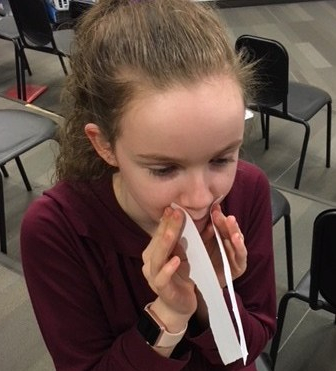
Try the same demonstration with a hair dryer:
Tape two pieces of paper to either side of a hair dryer. Again, when you turn the
hair dryer on the negative pressure between the two pieces of paper causes the
papers to adduct together just like the vocal folds.
BUILD A WORKING LUNG AND DIAPHRAGM
For this activity you’ll need:
1. A clean, dry Gatorade bottle
2. Scissors
3. Tape
4. Two balloons
Step 1. Cut 1/4th of the bottom of the bottle with the scissors. I have found through
experience that Gatorade bottles are easiest to cut with scissors. You will still need tohelp young students get the cutting started.
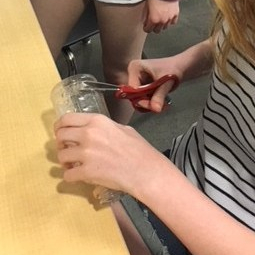
Step 2a. Tie the end of one balloon into a knot.
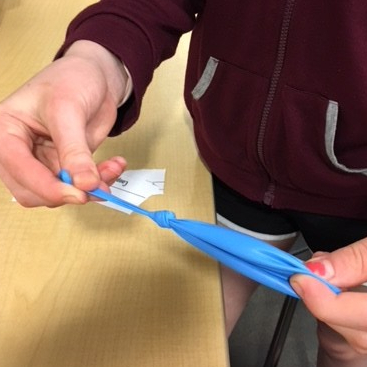
Step 2b. Then cut off about 1/4th of the larger end of the balloon.
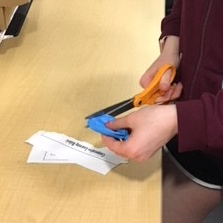
Step 3. Wrap the open part of the balloon around the bottom, open end of bottle. This is where you put tape around the circumference of the balloon to make it stay.
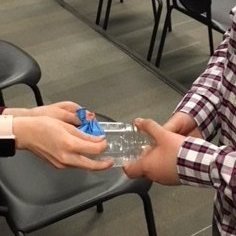
Step 4. Take the second balloon and put the larger part down through the inside of the bottle then wrap the open, small end of the balloon around the lip.
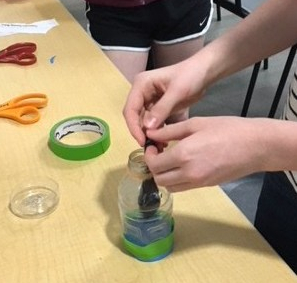
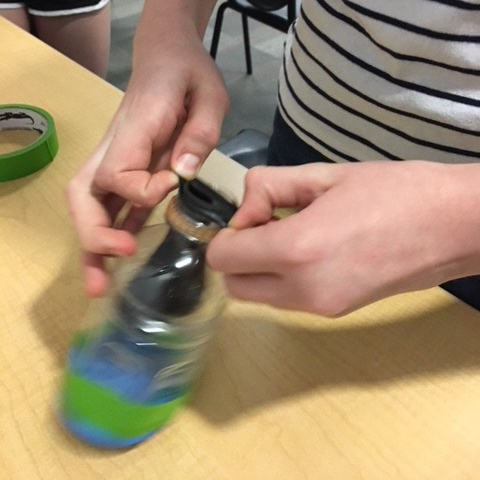
You’re finished! You should be able to pull on the end of the “diaphragm” balloon and the “lung” balloon will expand and fill with air.


STROBOSCOPIC VIDEOS
- Don’t be afraid to show stroboscopic videos of vocal folds in use. Please click below to view YouTube videos:
- Normal phonating folds
Vocal fold paralysis - Vocal fold nodules or polyps
If you want to really drive home the importance of not smoking show them a picture of laryngeal cancer…but only if your class can handle it! Spoiler alert: It’s pretty gross!
These activities alone won’t improve tone or range, but they provide a foundation of knowledge that students will need in order to address deficiencies in their technique. They represent a starting point on the road to understanding the mechanics of the voice. Future posts will address more specific strategies you can use with your students, but as with anything, start with the basics and keep it simple!
References:
Pro-Singing Voice, LLC. (2012). Images. https://www.google.com/search?q=Bernoulli+Pro+Singing+Voice+2012&newwindow=1&safe=active&rlz=1C1CHZL_enUS761US762&source=lnms&tbm=isch&sa=X&ved=0ahUKEwjtuKy1-IbbAhVHslQKHXOPBY0Q_AUIDCgD&biw=1266&bih=585#imgrc=db7r9VNlHP7Q0M:
Sale, J. (2013). Basic Voice Anatomy.
Freer, P. (2005). Success for Adolescent Singers~Unlocking the Potential in Middle School Choirs. Choral Excellence.


Leave a Reply
You must be logged in to post a comment.